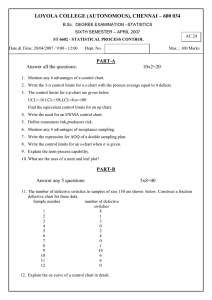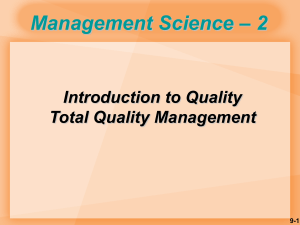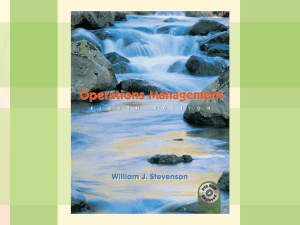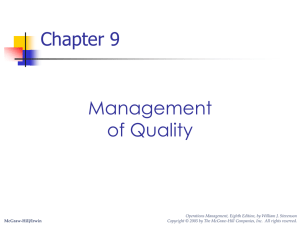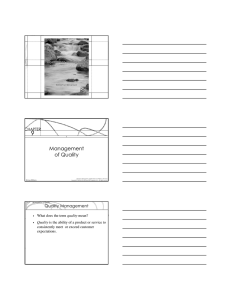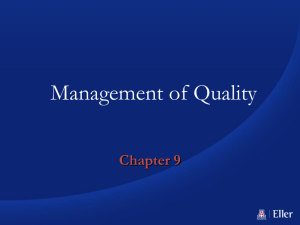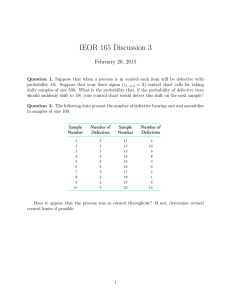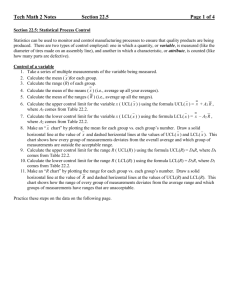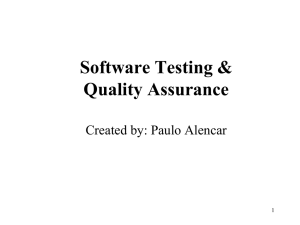CH9 AND CH11 QUALITY MANAGEMENT and TQM
advertisement
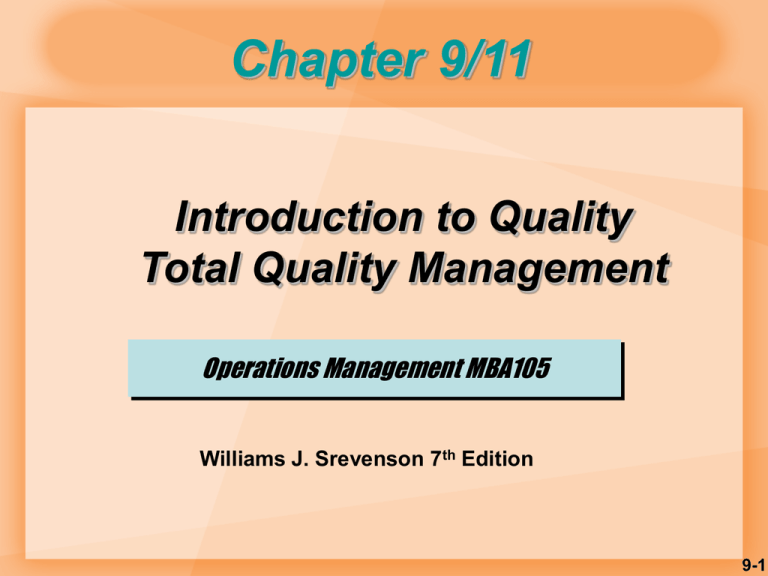
Chapter 9/11 Introduction to Quality Total Quality Management Operations Management MBA105 Williams J. Srevenson 7th Edition 9-1 Learning Objectives Define quality. Importance of quality. Determinants of quality. Costs & quality. Quality awards. quality gurus TQM Quality tools 9-2 Quality Management What does the term quality mean? Quality is the ability of a product or service to consistently meet or exceed customer expectations. degree of excellence of a thing. Totality of features and characteristics that satisfy needs 9-3 Quality Cost and Productivity Vs. Quality USA Organizations Focus in Cost and productivity (2nd war – mid 1980s) WHY AMERICAN ORGANIZATIONS BEHAVIOR CHANGE TWARD QUALITY?? 9-4 Evolution of Quality Management Fredrick Taylor (Scientific Management) 1924 - Statistical process control charts 1930 - Tables for acceptance sampling 1940’s - Statistical sampling techniques 1950’s - Quality assurance/TQC (DEMING) 1960’s - Zero defects 1970’s - Quality assurance in services 9-5 Quality Assurance vs. Strategic Approach Quality Assurance Emphasis on finding and correcting defects before reaching market Strategic Approach Proactive, focusing on preventing mistakes from occurring Greater emphasis on customer satisfaction 9-6 Dimension of Quality Which type of fuel you prefer to your car MOMTAZ or GAID Which Car you prefer CAMRY OR LUMINA FULL OPTIONS OR NORMAL OPTION Did you prefer health centre or private clinic 9-7 Dimensions of Quality Performance basic operating characteristics of a product; how well a car is handled. Features “extra” items added to basic features, such as a stereo CD or a leather interior in a car Reliability probability that a product will operate properly within an expected time frame; that is, a TV will work without repair for about seven years 9-8 Dimensions of Quality (Cont’d) Conformance degree to which a product meets pre– established standards Durability how long product lasts before replacement Serviceability ease of getting repairs, speed of repairs, courtesy and competence of repair person 9-9 Dimensions of Quality (Cont’d) Aesthetics how a product looks, feels, sounds, smells, or tastes Safety assurance that customer will not suffer injury or harm from a product; an especially important consideration for automobiles Perceptions subjective perceptions based on brand name, advertising, and the like 9-10 Examples of Quality Dimensions Dimension (Product) Automobile 1. Performance Everything works, fit & finish Ride, handling, grade of materials used 2. Aesthetics (Service) Auto Repair All work done, at agreed priceFriendliness, courtesy, Competency, quickness Interior design, soft touch Clean work/waiting area 3. Special features Gauge/control placement Location, call when ready Cellular phone, CD Computer diagnostics player 9-11 Examples of Quality Dimensions (Cont’d) D im ension (P roduct) A utom obile (S ervice) A uto R epair 5. R eliability Infreq uency of breakdow ns W ork done correctly, ready w hen prom ised 6. D urability U seful life in m iles, resistance to rust & corrosion W ork holds up over tim e 7. P erceived q uality T op-rated car A w ard-w inning service departm ent 8. S erviceability H andling of com plaints and/or H andling of com plaints req uests for inform ation 9-12 Dimensions of Quality: Service Time and Timeliness How long must a customer wait for service, and is it completed on time? Is an overnight package delivered overnight? Completeness: Is everything customer asked for provided? Is a mail order from a catalogue company complete when delivered? 9-13 Dimensions of Quality: Service Courtesy: How are customers treated by employees? Are catalogue phone operators nice and are their voices pleasant? Consistency Is the same level of service provided to each customer each time? Is your newspaper delivered on time every morning? 9-14 Dimensions of Quality: Service Accessibility and convenience How easy is it to obtain service? Does a service representative answer you calls quickly? Accuracy Is the service performed right every time? Is your bank or credit card statement correct every month? 9-15 Dimensions of Quality: Service Responsiveness How well does the company react to unusual situations? How well is a telephone operator able to respond to a customer’s questions? 9-16 Challenges with Service Quality Customer expectations often change Different customers have different expectations Each customer contact is a “moment of truth” Customer participation can affect perception of quality Fail-staffing must be designed into the system 9-17 Quality Gurus Walter Shewart In 1920s, developed control charts Introduced the term “quality assurance” W. Edwards Deming Developed courses during World War II to teach statistical quality-control techniques to engineers and executives of companies that were military suppliers After the war, began teaching statistical quality control to Japanese companies Joseph M. Juran Followed Deming to Japan in 1954 Focused on strategic quality planning 9-18 Quality Gurus (cont.) Armand V. Feigenbaum In 1951, introduced concepts of total quality control and continuous quality improvement Philip Crosby In 1979, emphasized that costs of poor quality far outweigh the cost of preventing poor quality In 1984, defined absolutes of quality management— conformance to requirements, prevention, and “zero defects” Kaoru Ishikawa Promoted use of quality circles Developed “fishbone” diagram Emphasized importance of internal customer 9-19 Deming’s 14 Points 1. 2. 3. 4. 5. 6. 7. 8. 9. 10. 11. 12. 13. 14. Create constancy of purpose Adopt philosophy of prevention Cease mass inspection Select a few suppliers based on quality Constantly improve system and workers Institute worker training Instill leadership among supervisors Eliminate fear among employees Eliminate barriers between departments Eliminate slogans Remove numerical quotas Enhance worker pride Institute vigorous training and education programs Develop a commitment from top management to implement above 13 points 9-20 Determinants of Quality (cont’d) Quality of design Intension of designers to include or exclude features in a product or service: Different car models with different features size Appearance Roominess Fuel economy Comfort Material used 9-21 Determinants of Quality (cont’d) Quality of Conformance Making sure a product or service is produced according to design: if new tires do not conform to specifications, they wobble if a hotel room is not clean when a guest checks in, the hotel is not functioning according to specifications of its design 9-22 Determinants of Quality (cont’d) Ease of Use Instruction manuals Guide the customer for proper used good labeling Service after Delivery 9-23 The Consequences of Poor Quality Loss of business Liability Productivity Costs 9-24 Benefits of Good Quality Organizations will benefit in different way: Enhance reputation Increase market share Greater customer loyalty Lower liability Cost Fewer complains Lower production cost Higher profits 9-25 Responsibility for Quality Top management Design Procurement Production/operations Quality assurance Packaging and shipping Marketing and sales Customer service 9-26 Costs of Quality Failure Costs - costs incurred by defective parts/products or faulty services. Internal Failure Costs Costs incurred to fix problems that are detected during the production. Defective materials Incorrect machine setting Faulty equipment Carelessness Wrong procedure 9-27 Costs of Quality External Failure Costs All costs incurred to fix problems that are detected after the product/service is delivered to the customer. Warranty work Handling of complains Replacement Liability 9-28 Costs of Quality (continued) Appraisal Costs Costs of activities designed to ensure quality or uncover defects Cost of inspector Testing Test equipment Labs Field testing 9-29 Costs of Quality (continued) Prevention Costs Cost of preventing defects form occurring Planning and adminstration Working with vendors Training Quality control procedures 9-30 Total Quality Management A philosophy that involves everyone in an organization in a continual effort to improve quality and achieve customer satisfaction. Continuous Improvement Involvement of Everyone Customer Satisfaction 9-31 Elements of TQM 1. Continual improvement (never ending) 2. Competitive benchmarking 3. Employee empowerment 4. Team approach 5. Decisions based on facts 6. Knowledge of tools 7. Supplier quality 8. Champion 9. Quality at the source 10. Suppliers 9-32 Continuous Improvement Philosophy that seeks to make neverending improvements to the process of converting inputs into outputs. Kaizen: Japanese word for continuous improvement. 9-33 Quality at the Source The philosophy of making each worker responsible for the quality of his or her work. 9-34 Process Improvement and Tools Process improvement - a systematic approach to improving a process Process mapping Analyze the process Redesign the process Tools There are a number of tools that can be used for problem solving and process improvement Tools aid in data collection and interpretation, and provide the basis for decision making 9-35 Basic Quality Tools Flowcharts Check sheets Histograms Pareto Charts Scatter diagrams Control charts Cause-and-effect diagrams Run charts 9-36 Quality Tools Flow Chart : displays the steps in a process showing order and relationships helps in understanding of that process and identifies potential weaknesses i.e. poor performance Cause and Effect Also know as fishbone or Ishikawa 9-37 Quality Tools P oke-Y ok e seeking to avoid inadvertent errors F ailure M od e E ffect A n alysis(F M E A ) Q uantifies the possibilities of failure, the effect of failure and w eighs up the likelihood Q u ality C ircles feedback groups that voice problem s and suggest solutions T ally or C h eck sh eet R ecords frequency 9-38 Quality Tools P areto C h art a form of bar-chart w hich displays the relative im portance of problem s or conditions by ordering frequency and show ing the cum ulative effect H isto gram d isplayin g variatio n in a p rocess tryin g to exp lain th e cause of it N o te: B o x W hisker Plots w o uld be a u seful ad d itio n to this Scatter Graph looks for relationships between factors and displays their strength 9-39 Quality Tools Clustering Reduces complexity or size of data set by grouping ideas under headingsUseful for qualitative data from questionnaires Filtering ideas Reduces ideas by asking questions e.g. Is the idea feasible? Affordable? Is it within our control? Would it improve the situation? 9-40 Flow Chart Start/ Finish Operation Operation Decision Operation Operation Operation Decision Start/ Finish 9-41 Check Sheet COMPONENTS REPLACED BY LAB TIME PERIOD: 22 Feb to 27 Feb 2002 REPAIR TECHNICIAN: Bob TV SET MODEL 1013 Integrated Circuits Capacitors Resistors Transformers Commands CRT |||| |||| |||| |||| |||| |||| || || |||| | 9-42 Histogram 20 15 1 0 5 0 1 2 6 13 10 16 19 17 12 16 2017 13 5 6 2 1 9-43 Pareto Analysis CAUSE NUMBER OF DEFECTS Poor design Wrong part dimensions Defective parts Incorrect machine calibration Operator errors Defective material Surface abrasions PERCENTAGE 80 16 12 7 4 3 3 64 % 13 10 6 3 2 2 125 100 % 9-44 70 (64) Percent from each cause 60 50 40 30 20 (13) 10 (10) (6) (3) (2) (2) 0 Causes of poor quality 9-45 Scatter Diagram Y X 9-46 Control Chart 1020 UCL 1010 1000 990 LCL 980 970 0 1 2 3 4 5 6 7 8 9 10 11 12 13 14 15 9-47 Cause-and-Effect Diagram Figure 9.12 Measurement Faulty testing equipment Environment Old / worn Inadequate training Quality Problem Defective from vendor Not to specifications Dust and Dirt Tooling problems Lack of concentration Improper methods Machines Out of adjustment Poor supervision Incorrect specifications Inaccurate temperature control Human Materialhandling problems Materials Poor process design Ineffective quality management Deficiencies in product design Process 9-48 Diameter Run Chart Time (Hours) 9-49 Tracking Improvements Figure 9-18 UCL UCL UCL LCL LCL LCL Process centered Process not centered and stable and not stable Additional improvements made to the process 9-50 Methods for Generating Ideas Brainstorming Quality circles Interviewing Benchmarking 5W2H 9-51 Quality Circles Team approach List reduction Balance sheet Paired comparisons 9-52 Benchmarking Process Identify a critical process that needs improving Identify an organization that excels in this process Contact that organization Analyze the data Improve the critical process 9-53
